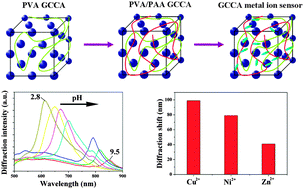Photonic crystal pH and metal cation sensors based on poly(vinyl alcohol) hydrogel†
Abstract
A facile strategy for the preparation of poly(vinyl alcohol) (PVA)/poly(acrylic acid) (PAA) photonic crystal materials with pH and metal

* Corresponding authors
a
Key Laboratory for Ultrafine Materials of Ministry of Education, School of Materials Science and Engineering, East China University of Science and Technology, Shanghai 200237, China
E-mail:
yhzhu@ecust.edu.cn
Fax: +86 21 6425 0624
Tel: +86 21 6425 2022
A facile strategy for the preparation of poly(vinyl alcohol) (PVA)/poly(acrylic acid) (PAA) photonic crystal materials with pH and metal

 Please wait while we load your content...
Something went wrong. Try again?
Please wait while we load your content...
Something went wrong. Try again?
H. Jiang, Y. Zhu, C. Chen, J. Shen, H. Bao, L. Peng, X. Yang and C. Li, New J. Chem., 2012, 36, 1051 DOI: 10.1039/C2NJ20989F
To request permission to reproduce material from this article, please go to the Copyright Clearance Center request page.
If you are an author contributing to an RSC publication, you do not need to request permission provided correct acknowledgement is given.
If you are the author of this article, you do not need to request permission to reproduce figures and diagrams provided correct acknowledgement is given. If you want to reproduce the whole article in a third-party publication (excluding your thesis/dissertation for which permission is not required) please go to the Copyright Clearance Center request page.
Read more about how to correctly acknowledge RSC content.
 Fetching data from CrossRef.
Fetching data from CrossRef.
This may take some time to load.
Loading related content
